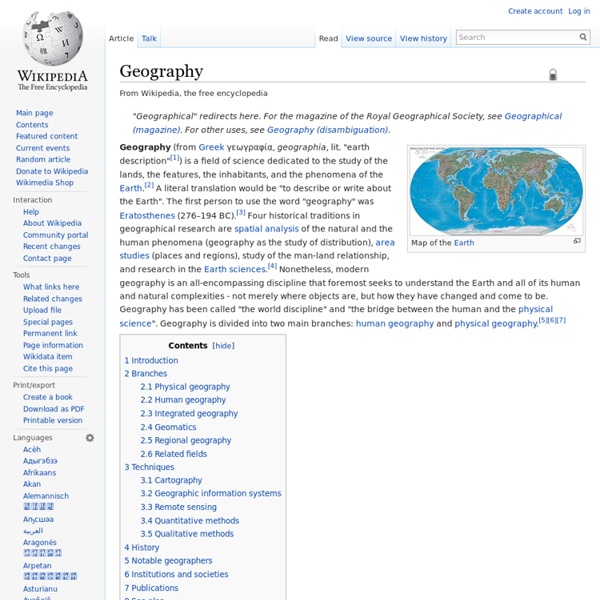the world according to Americans.
Portal:Geography
From Wikipedia, the free encyclopedia Wikipedia portal for content related to Geography Geography (from Greek: γεωγραφία, geographia. Combination of Greek words ‘Geo’ (The Earth) and ‘Graphien’ (to describe), literally "earth description") is a field of science devoted to the study of the lands, features, inhabitants, and phenomena of Earth. Featured articles are displayed here, which represent some of the best content on English Wikipedia. Trafford Park is an area of the Metropolitan Borough of Trafford, Greater Manchester, England, opposite Salford Quays on the southern side of the Manchester Ship Canal, 3.4 miles (5.5 km) southwest of Manchester city centre and 1.3 miles (2.1 km) north of Stretford. Vital article Land, also known as dry land, ground, or earth, is the solid terrestrial surface of Earth not submerged by the ocean or another body of water. Featured biography Featured biography articles in geography You can read about interesting Wikipedia articles about places around you.
Geography
Geography Geography is more than maps. It's basic to any understanding of how to get from one place to another--in your head or on paper! Check out the links below to see how wide the world is. Basic Geography: The Equator and the Prime Meridian The earth is a globe, of course, and can be divided into lots of lines called latitude and longitude. Easter Island: Land of Giant Stones and Mysteries In the Pacific Ocean, thousands of miles away from the nearest population center, lies Easter Island, a strange and mysterious place famous for what happened there many years before and what kind of evidence has been left behind. The Ten Longest Rivers in the World You know the Nile River is the longest in the world, right? The River as Boundary For thousands of years, rivers have served as lines of division between civilizations, political entities, and religious groups. Bodies of Water Bodies of water have names that are sometimes similar and sometimes different. Next 1 2
CU-Boulder Geography
Outline of geography
From Wikipedia, the free encyclopedia Hierarchical outline list of articles related to geography Geography – study of earth and its people.[1] Nature of geography[edit] Geography as[edit] an academic discipline – a body of knowledge given to − or received by − a disciple (student); a branch or sphere of knowledge, or field of study, that an individual has chosen to specialize in. Branches of geography[edit] As "the bridge between the human and physical sciences," geography is divided into two main branches: human geographyphysical geography[3][4] Other branches include: integrated geographytechnical geographyregional geography All the branches are further described below... Physical geography[edit] Physical geography – examines the natural environment and how the climate, vegetation & life, soil, water, and landforms are produced and interact.[5] Fields of physical geography[edit] Approaches of physical geography[edit] Human geography[edit] Fields of human geography[edit] Integrated geography[edit] 1.
Wikipedia:Contents/Geography and places
Wikipedia's contents: Geography and places
Category:Geographical areas
From Wikipedia, the free encyclopedia this category is for specific geographical areas or regions that are delineated by natural features such as meadows, deserts, etc. any geographical regions that are political regions in nature, eg of a country or other political unit, would go in Category:Geographical regions Subcategories This category has the following 22 subcategories, out of 22 total. Pages in category "Geographical areas" The following 2 pages are in this category, out of 2 total.
Category:Geography stubs
From Wikipedia, the free encyclopedia When appropriate, an even more specific template should be used from among those noted below. Articles about specific buildings and structures use the {{Struct-stub}} template and sub-category, or one of its subtypes.Articles about topographical terms used in geography use the {{Topography-stub}} template and sub-category, or one of its subtypes.Articles about other terminology used in geography use the {{Geo-term-stub}} template and sub-category, or one of its subtypes.Articles about roads, streets, and highways use the {{Road-stub}} template and subcategory, or one of its subtypes. Country-specific templates[edit] {{UK-geo-stub}} for the United Kingdom{{US-geo-stub}} for the United States{{Maldives-geo-stub}} for the Maldive Islands (many island groups follow this pattern - Bahamas, Marshalls, Solomons, etc.) Subcategories This category has the following 27 subcategories, out of 27 total. Pages in category "Geography stubs"



